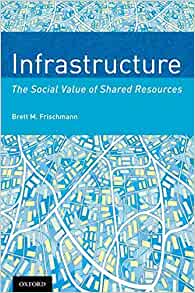I recently finished re-reading Brett Frischmann’s (2012) Infrastructure: The Social Value of Shared Resources. It’s very interesting although I don’t entirely agree with his conceptualisation. The reason for going back to it is a convergence of two issues I’ve been thinking about.
One is the idea of social infrastructure. This was centre stage in Eric Klinenberg’s book Palaces for the People, on which we had an excellent Bennett Institute event. A report on The Value of Social Infrastructure by my colleagues Michael Kenny and Tom Kelsey aroused a lot of impact across the UK government and beyond. I’ve been writing about the health system as social infrastructure – am currently writing a handbook chapter as a follow-up to this paper (revised version forthcoming in NIER). So the questions concern definition and measurement: what is social infrastructure, can it be intangible as well as tangible, how does it relate to the older concept of social capital? etc.
The second is the puzzle about infrastructure in general: what to invest in and what are its (spatial) economic impacts? Bent Flyjberg has amassed a great deal of evidence that major projects generally fail – they are over-budget, late and have disappointing impact. (See eg this paper on how far projects fail their cost benefit analysis assumptions.) And the examples of white elephant projects are legion. Yet the economy must have infrastructure to function at all. How to reconcile the paradox? And why has construction (which includes infrastructure) itself been so low productivity?
Frischmann’s book is helpful in thinking through the questions. One key point is that demand for infrastructure is derived: people want it to be able to carry out activities that feed into final demand. And infrastructure is a social good that will change context and social relations. It’s generic – can be used for many purposes. Spillovers are inherent, and large – and difficult to measure. Infrastructure also creates private and social option value.
He defines infrastructure as being identified by the following characteristics:
–Non-rival over certain portion of demand (although congestion possible)
–Provides stream of services over time
–Demand is derived, for infrastructure capital services as productive inputs into other activities
I think this omits universal service need/obligation as a key aspect. I find his classification of types of infrastructure (commercial, public, social) a bit odd too. That said, the book is very useful in thinking about the ‘essential white elephant’ paradox.
Resolution of the paradox will require finding a way for policymakers or investors to judge whether a project is a white elephant worth having. I was discussing this with David Cleevely, a successful Cambridge investor, in the context of a forthcoming paper of mine in an issue of the Oxford Review of Economic Policy on major projects. Why, I asked David, did the Victorians manage to build so much infrastructure that we in the UK are still using after 150 years? He made the powerful point that the advantage the Victorians had (compared to economists today deploying cost benefit analysis) was that they could imagine a future in which the infrastructure they were going to build would have transformative effects. Applying this thinking now, for example, we know the future will be renewable energy-based, so projects need to be evaluated in the light of this transformed world.
I don’t know how much infrastructure investment we need altogether in the UK, but definitely more, and social infrastructure definitely counts too. To be continued….

